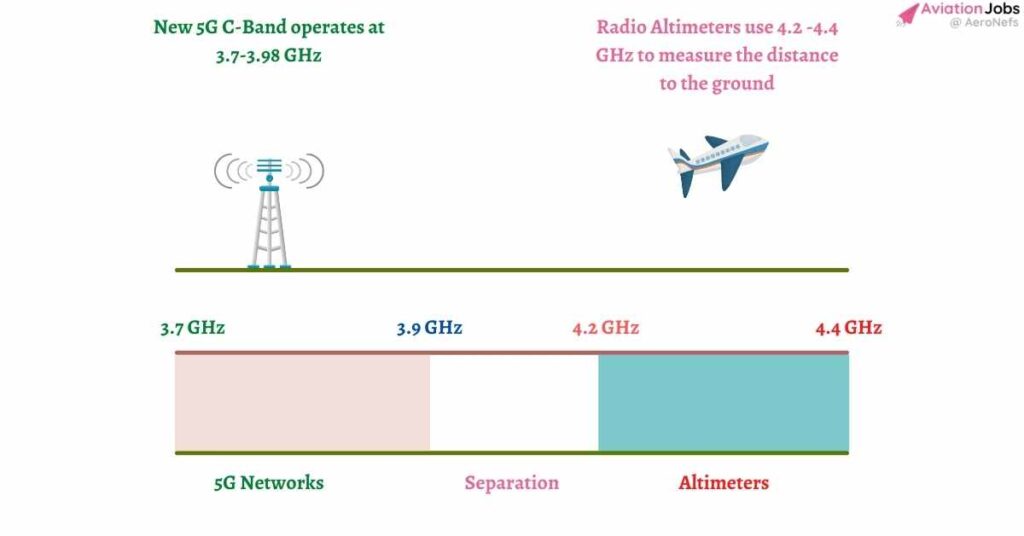Not too long ago, the telecom companies like AT&T and Verizon deployed their new 5G services near US airports which raised concerns among the aviation authorities. The Federal Aviation Administration (FAA) warned about how the new 5G C-band services could impede flight operations and aviation safety. Following the rollout of the services, many airlines cancelled their flights in and out of the US. In fact, according to Flightaware, around 2 % of the flights in the US was cancelled.
How does 5G C-Band impact Aviation Safety?
Before comprehending how 5G impacts Aviation Safety, it is essential to know what it really is.
What is 5G C-Band?
5G is the fifth generation network followed by 4G. It is designed to deliver data at a very high speed of approximately 20 Gigabits-per-second (Gbps).
C band is the frequencies that sit between 4 GHz and 8 GHz. In other words, it is the frequencies that are present in the mid electromagnetic spectrum.
5G favours C-band as they enable higher throughput than their previous generations. In simple terms, they allow a high amount of data to be transferred from source to destination within a given timeframe. Furthermore, due to other favourable characteristics such as covering a lot of geography with just a small number of towers, 5G prefers the mid-band spectrum.
What is the matter of concern?

Telecom companies like Verizon and AT&T are using up frequencies between 3.7 to 3.98GHz. These frequencies are highly favourable for 5G networks since they need broad and more directed channels to enable fast transmission as promised.
However, the C-band towers, especially near airports can hinder flight operations and cause a major threat to aviation safety.
The altimeter of the airplane operates in the 4.2-4.4 GHz frequency range.
The altimeter aids a pilot to determine the altitude and also, the distance between the airplane and its destination, especially in low visibility conditions. For instance, if the weather is bad, the pilot highly relies on flight instruments like an altimeter to safely reach the destination.
The frequencies in which radio altimeters of the airplane operate i.e 4.2-4.4 GHz and the frequencies of the newly deployed C-band 5G networks i.e 3.7 to 3.98GHz are almost the same. Therefore, this could lead to unsafe interference and perhaps lead to a major aviation crisis.
Fortunately, with timely interventions, this crisis was averted.
C-Band 5G has been rolled out in many countries – why is aviation interference not an issue in those countries?
The C-band 5G has been deployed in around 40 countries other than the US. However, those countries have no complaints about aviation interference. This is because other countries use a frequency range much lower than the one auctioned by the US.
For instance, European countries like France are using frequencies between 3.6-3.8 GHz that sits further away from the altimeter frequency i.e 4.2-4.4 GHz.
Furthermore, due to the factors such as the placement of the antennas farther from the airfields, lower power levels, and the right antenna adjustments, there are no aviation interference issues yet by other countries.
Bottom Line
The telecom companies have agreed to delay their rollout of C-band 5G networks near a few key US airports allowing the airlines to resume their services. Meanwhile, the US authorities are identifying ways to mitigate this issue.
At home, following the incident, the Federation of Indian Pilots raised a concern to the Civil Aviation Minister asking that:
“DGCA and the Telecom Regulatory Authority of India work together to develop a plan that enables the safe and efficient implementation of 5G mobile communications services in the C-Band. It is critical to fully understand and mitigate potential 5G signal interference with radio altimeters that are integral to aircraft safety systems”.
For more updates, follow AERONEFS.
Do you think India would face similar problems like the US? Let us know in the comments.


